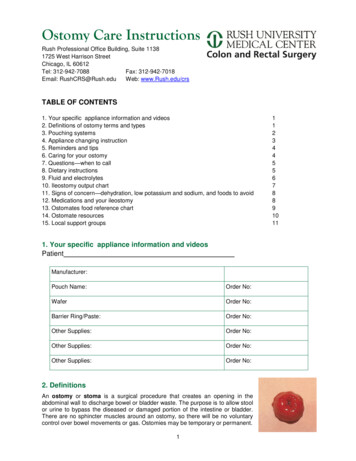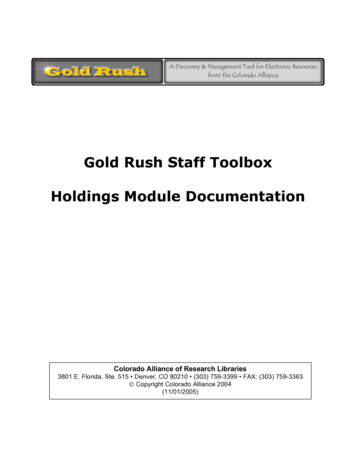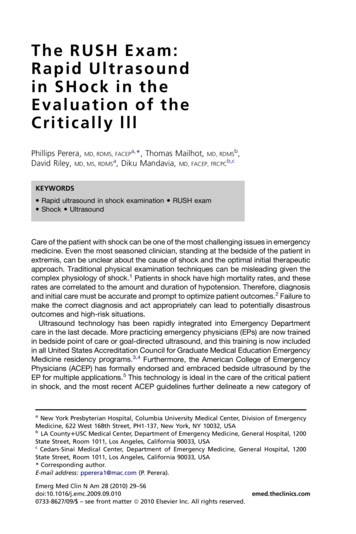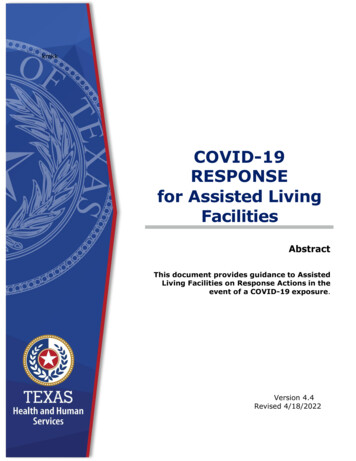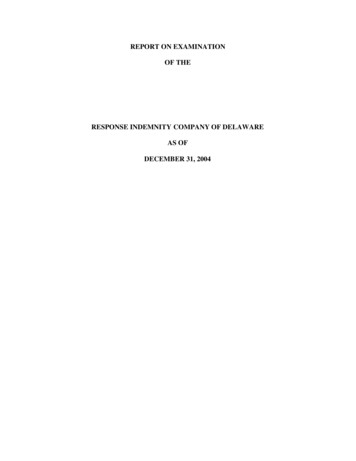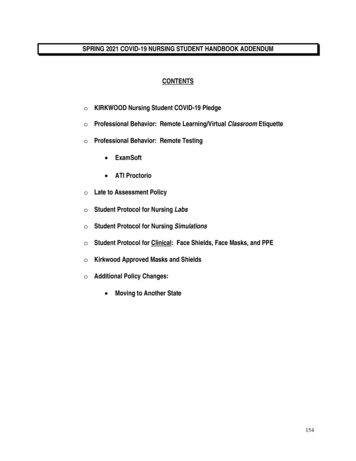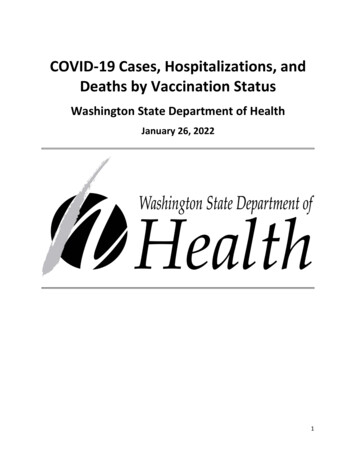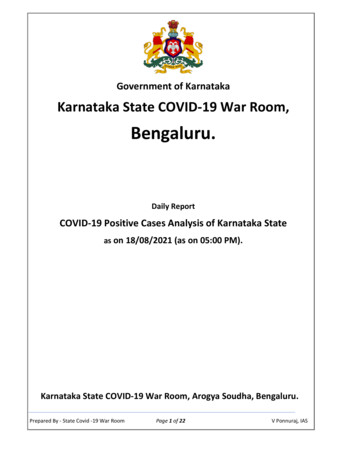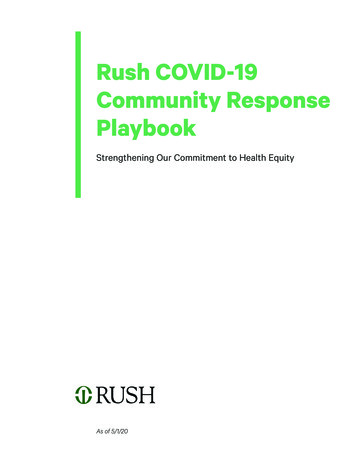
Transcription
Rush COVID-19Community ResponsePlaybookStrengthening Our Commitment to Health EquityAs of 5/1/20
Table of ContentsChapter 1:Chapter 2:Chapter 3:Chapter 3:Rush's Commitment to Health EquityKey Response Strategies and TacticsFocus AreasThe Path Forward571434Rush University Medical Center3
RUSH Overview:Health systems across Chicago and the country are responding to COVID-19 withconcerted efforts on workforce deployment, medical care capabilities and supply chainmanagement. In addition, the COVID-19 pandemic has increased health-related socialneeds, exacerbating underlying inequities that have long led to worse health outcomesamong black and Latinx communities.The COVID-19 pandemic calls for social services to identify and address social needs,accessible and trauma-informed mental health treatment, health promotion activitiesthat support continued chronic care management during the pandemic and outreachtargeted to communities most impacted by the harmful effects.At Rush University System for Health, an integrated academic health system spanningthe West Side of Chicago, Oak Park and Aurora, partners from across the institutionhave worked extensively on many of these issues for years. Together with residents,community leaders, nonprofit organizations and other health care institutions, our goalis to be a catalyst for community health and vitality by dismantling barriers to health,and by promoting health equity both within and outside of Rush. This playbook describeshow these partners have come together given the COVID-19 pandemic to align and elevateexisting efforts, identify new needs and fill in gaps to best support patients, families andcommunity members in our service areas.Our approach mostly focuses on those particularly impacted by COVID-19, including butnot limited to: Communities of color Immigrants Individuals with disabilities LGBTQ individuals Older adults People experiencing homelessnessThis document shares our approach and materials, as of May 5, 2020.4Rush University Medical Center
Chapter 1Rush’s commitmentto health equityRush University Medical Center5
OverviewA hospital’s mission is to help heal people — and that’s why Rush University System for Health continuallyworks to address the social inequities that contribute to poor health. People who live in the neighborhoodsat the center of Rush’s service area are working through the effects of decades of structural racism andeconomic deprivation, including higher levels of poverty and unemployment, crowded housing, and lowerrates of education and health insurance.The resulting inequities have a far-reaching impact on community well-being — an impact starklyillustrated by the fact that life expectancy for a resident of Chicago’s Loop is 85 years, while six miles westthe life expectancy for a resident of the West Garfield Park neighborhood is just 69 years.Because inequities are so deeply rooted in our social systems and structures, a team approach is required.We are coordinating our efforts and resources with other health systems, community residents, nonprofitorganizations, government agencies and faith communities.Health equity is a systemwide strategy for achieving Rush’s mission: to improve the health of theindividuals and diverse communities we serve through the integration of outstanding patient care,education, research and community partnerships. Together, we can have a greater collective impact in ourcommunities.Community-focused, cross-collaborative leadershipShortly after Illinois’ shelter-in-place order began, Rush’s community health equity and engagement team,population health and social work services team, and Rush University’s College of Nursing came togetherto launch our Community Command Center (CCC) to best meet the needs of those we serve. Teamsquickly galvanized across the institution to achieve one overarching goal: To advance and align initiativesand maximize the effectiveness of Rush’s response to COVID-19, in particular among communities mostvulnerable to adverse outcomes.The CCC builds on existing programs at Rush designed to address community needs. Because of theurgent nature of the response to community members, the CCC quickly gathered diverse representationacross Rush to synthesize needs and identify areas of focus, to create working groups around these needsleveraging existing roles and partnerships, and to track process measures for reporting and improvementcycles.Many different existing and new initiatives grew from these efforts, which are categorized according to thefollowing focus areas: Population and community health activitiesand care Emergency food support Proactive outreach calls to at-risk populations Education and resource connection for olderadults Social work helplines Support for homeless shelters Health education and wellness programming Support for Rush staff and providers Social connection support and mental healthtreatment6Rush University Medical Center
Chapter 2Key responsestrategies andtacticsRush University Medical Center7
Interprofessional and cross-departmental collective approachThe Community Command Center, or CCC, coalition is comprised of an interprofessional and crossdepartmental group of over 50 Rush staff, providers and local partners. The coalition grew from an original20 participants, who initially met on Friday, March 20, 2020, and continues to grow through organicnetworking.Preventive MedicineFamily MedicinePhilanthropyRush Alzheimer’s Disease CenterInpatient Care ManagementGovernment RelationsSocial Work andCommunity HealthHuman ResourcesInpatient and Outpatient NursingCommunityCommand CenterEmergency DepartmentPopulation HealthWomen and ChildrenAdult MedicineInterpreter ServicesMarketing and CommunicationsResearch AffairsCommunity HealthEquity and EngagementCollege of Nursing – Faculty Practiceand Community, Systems, and MentalHealth NursingProvider Offices Rush Oak Park Physicians Group Rush University Medical GroupOur key institutional partner NowPow was also a member of the CCC team.This diverse representation has allowed the CCC to respond to a broad range of population and communityhealth needs.Regular meetings identify needs and strategic workThe CCC began meeting three times a week (Monday, Wednesday and Friday) for one hour to buildmomentum and rapidly respond to identified needs. In late April, the CCC tapered down to twice weekly tomaintain momentum but free up time.8Rush University Medical Center
Community collaboration“Critical to this effort was setting the table with everyone because we can think better asa group. It’s a table to which everyone is invited. As problems have risen in the morning,we’ve tried to solve them in the afternoon.”– David Ansell, MD, MPH, senior vice president, community health equity and associate provost, community affairsSurveying community partners about their needs was our first step for building our institutional strategy.Shortly after Illinois’ shelter-in-place orders went into effect, we electronically surveyed 65 communitybased organizational partners and faith-based organizations to assess needs and barriers as well as offeraccess to resource information. Of those, 18 partners responded.Primary gaps reported related to the following: Communicating with community members who did not have internet access Concern about not having reliable resource information readily available Food access Receiving accurate information about COVID-19Survey respondents were offered access to NowPow, a social service resource referral platform for emergentneeds of community members. Rush uses this tool in its care management and coordination effortsacross various places in the Rush system to identify what patients’ needs are around social and structuraldeterminants of health and to connect them with community resources. Out of the 18 community partners,10 have signed up for the platform.Community partners received additional follow-up calls to further determine needs and/or concerns.Rush University Medical Center9
Needs did not change; however, an additional concern arose around students being home all day withoutstructure, particularly those students who live with older adults (grandparents). Emails from school leadersalso elicited a better understanding of immediate needs for students.Survey Examples Community-based organizations (English) Faith-based organizations (English and Spanish)Other ways of gathering information to identify community needs included the following: College of Nursing Faculty Practice partner organizations requests for support and input Input from Health Ambassadors and Advisory Council members from Rush Generations, a healthpromotion program for adults and caregivers that provides over 16,000 members with access toinformation and resources geared toward health and aging West Side COVID-19 Homeless Coalition daily meetings assessing needs Direct outreach to aging-related partners on the West Side, including Geriatric Workforce EnhancementProgram participants and the City of Chicago’s Department of Family and Support Services/SeniorWellness Centers Communications on local news outlets and professional networks, including Austin Weekly Newsneighborhood news outlet and Chicago Bridge network of local providers who care for older adults Documentation and clinical supervision with care managers and community health workers providingindividual-level interventions to thousands of non-COVID patients with exacerbated social care needsand to over 2,500 COVID-positive patients to dateIn addition to CCC work, our community leaders are also actively involved in citywide health equity COVIDresponse initiatives. Rush has been an active partner on the City of Chicago’s Racial Equity Rapid ResponseTeam, with Rush’s senior vice president of community health equity, David Ansell, co-chairing the hospitaland health center group and our vice president of community health equity, Darlene Hightower, serving onthe communications group.10Rush University Medical Center
Communications and engagementTo spread the word about what resources Rush has available, we deployed a variety of vehicles andmethods, including:Outreach callsྲCalls made by numerous team members, including community health workers, social workers,nurse care managers, AmeriCorps members, staff volunteers, students and community volunteersE-newslettersྲRush GenerationsྲRush Education & Career Hub (REACH) newsletterྲCommunity Health Equity and Engagement (CHEE) newsletterWebinars and virtual town hallsྲTown hall fliersྲAccessible access instructions for Zoom participantsVIRTUAL TOWN HALLFOR MEDSTEM STUDENTSThursday, April 16th3-4 PM on ZoomJoin us for an information session and Q&A about COVID-19 and how itwill affect MedSTEM Pathways and MedSTEM Explorers this summer.Rukiya Curvey Johnson and Nia K. Benton will present and answerquestions about our programs. Katherine Dato, DNP and Dr. Kush Desiwill join as experts to answer questions about COVID-19.Register online at: www.reachatrush.org/news-events/Rush University Medical Center11
Websites12ྲRush COVID-19 Community ResourcesྲRush Center for Excellence in Aging - Coping ResourcesRush University Medical Center
Social mediaྲ@RushMedical (Instagram, Twitter); Rush University Medical Center (Facebook, LinkedIn)ྲRush Office of Community Health Equity and Engagement FacebookྲRush Generations FacebookWe also worked to make as many of these communications available in Spanish as well as English.Rush University Medical Center13
Chapter 3Focus Areas14Rush University Medical Center
Population and community health activities and careRush’s robust population and community health activities include the following: Robust care management offerings to support diverse patient populations, such as individualswith complex social needs, recently hospitalized individuals, LGBTQ individuals, and Medicaidbeneficiaries via phone and in person Local collaborations to improve the care ecosystem for our patients, including enhanced partnershipswith home health agencies and skilled nursing facilities, the West Side Accountable HealthCommunities Collaborative and a collaborative Adverse Childhood Experience Home Visiting initiative Proactive screenings for health-related social risks, Adverse Childhood Experiences and depressivesymptoms, across care settings (depending on the screening: inpatient, emergency department,primary care, select specialty care clinics) and in the community An integrated partnership with NowPow to facilitate referrals to community resources and to receivereferrals to internal Rush programs Mental health assessment, treatment and primary care integration for individuals 12 years old Confidential reproductive health services for adolescents and young adults A dedicated center for LGBTQ affirming care A transitional care program for individuals who visit the Emergency Department or hospital, but do nothave a primary care provider Health care delivery to vulnerable populations in the community via CON Faculty Practice inpartnership with nonprofit social service organizations, Rush’s three school-based health centers andthe Rush@Home house calls programIn collaboration with health care leaders across Rush, services are largely provided by the following teams: College of Nursing Office of Faculty Practice Department of Population Health Department of Social Work and Community Health Office of Community Health Equity and EngagementThe teams leading these initiatives have continued to provide ongoing care (described above) while alsoflexing programming and filling in supplemental roles to meet the needs of Rush diverse patients andcaregivers under COVID-19 including:Screening and testing: A 24/7 triage line staffed by RNs, with transfers to our Social Work Helpline for nonmedical concerns A drive-through clinic for COVID-19 screening and testing A COVID-positive clinic to create an alternative to seeing patients in the Emergency Department In-home testing for vulnerable patients who cannot come to be tested in person and reside in specifictarget ZIP codesRush University Medical Center15
Caring for COVID-positive patients: Inpatient and Emergency Department care managers are a key part of care teams still providing inperson assessment and discharge planning to COVID and non-COVID patients, and participating indaily multidisciplinary rounds Nurse and social work care managers follow up with individuals who test positive to offer support,navigation and resources – such as home-delivered meals, a referral for caregiver support, assistance onutilities or coping mechanisms Patient care navigator schedules follow-up visits for individuals who test positive Updated data and analytics dashboards to track COVID outcomes (including test results, admissions,ICU and ventilator use) by race, gender and age to identify trends and target proactive outreachContinuing and enhancing our population health activities: Standing up of telehealth to maintain continuity of care as much as possible – including for mentalhealth care provided by Social Work and Community Health and by Psychiatry and BehavioralSciences Ongoing care management, including advance care planning and support around procedurerescheduling, for diverse patient populations who access care at Rush, including those who screenpositive for two or more social needs or depression symptoms, are referred by outpatient provider, arehospitalized or visit the Emergency Department Respecting the rights of patients with disabilities for whom a support person may be essentialby implementing an organizational policy to accommodate their individual needs and allowing forassistance from a designated family or professional caregiver, despite limited visitation policies (seeRestricted Visitor Policy FAQs, and click the “exceptions” dropdown.) Bereavement supports as typically would be provided, including resources around funeralarrangements under COVID-19Health care delivery to vulnerable populations in the community: Transitioned all CON Faculty Practice primary care and home visiting activities to telehealth Transitioned all school-based health center primary care and mental health care to telehealth In some settings, telehealth allowed services to be expanded to additional settings Continuation of essential home visits to persons with serious mental illness with added safetyprecautions and PPE16Rush University Medical Center
Outreach methodsHere are a few examples of how our teams execute the initiatives above: A team of nurses delivers test results, and based on their clinical judgment, places an order for socialwork follow-up for the majority of patients who test positive and some of the patients with negative testresults. These referrals populate a work queue that social work care managers from the Social Work andCommunity Health and Population Health departments review and manage seven days a week. Theycall COVID-positive patients to screen and assess for the following:ྲCaregiver and social support needsྲFood insecurityྲNeeding a primary care physicianྲSanitizer and water needsྲUnderstanding precautions in transmission and leaving the home; medication accessྲWays of coping with self-isolationྲWorsening of symptoms Navigators, social workers and nurses have volunteered to fill extra shifts in the inpatient andemergency department due to staffing shortages, including cross-training outside typically-staffed unit/setting to accommodate surges in patients Proactive calls are being made by navigators and social workers to provide support around rescheduledprocedures, including for trans and gender-nonconforming patients seeking gender-affirmingtreatments who have had surgeries and other treatments postponed.Rush University Medical Center17
Proactive outreach calls to at-risk patients and community membersIn addition to our ongoing population health activities described above, we are also actively reachingout with proactive COVID-related calls to various groups who may be particularly at high risk for adverseimpacts of COVID-19, including the following individuals: Medicare beneficiaries with high risk of severe medical complications: We’re using a predictivealgorithm from ClosedLoop AI to identify Medicare beneficiaries most at risk for severe medicalcomplications should they become infected with COVID-19 and having nurse care managers conductproactive outreach, education and referrals Older adults residing on the West Side of Chicago, who are members of Rush Generations oridentified by local community groups as benefitting from friendly check-in calls Individuals who have visited the Chicago Emergency Department for non-COVID related reasons Individuals who have recently reported social needs, including food insecurity, in Rush’sEmergency Department or in community-based screening calls from employee volunteers andAmeriCorps members Caregivers of individuals who test COVID-positive at Rush, who have been identified by the socialwork and nurse care managers in their calls to COVID-positive patients as potentially benefitting fromcaregiver support City of Chicago Senior Center participants: Leveraging Rush’s contract with the City of Chicagoto perform well-being checks with past Senior Center participants, in collaboration with the City’sDepartment of Family & Support Services LGBTQ individuals receiving patient navigation services from Affirm: The Rush Center for Gender,Sexuality and Reproductive HealthOutreach methodsThese proactive outreach call efforts are underway to try to reach individuals who are at particular risk foradverse consequences of the COVID-19 pandemic due to a preexisting health condition or social need.We are leveraging a diverse workforce to make these calls, including nurse care managers (some redeployedfrom other departments/units), community health workers, patient navigators, AmeriCorps members andRush University student volunteers. We provide centralized guidance and upfront training to individualsmaking outreach calls for quality and consistency in intervention and documentation.Measurement opportunities for population health activities and care and outreach callsTo gauge our progress and continue to monitor the need, metrics we are tracking across initiatives include: Number of individuals successfully engaged Number of individuals with attempted outreach Types of needs identified and COVID-19 status Types of interventions provided, such as enrollment in Senior Connections weekly friendly calls orreferral to utilities assistance18Rush University Medical Center
Social work helplinesAlong with the proactive care management services and outreach calls described above, patients, familiesand community members can also call into Rush to access social work support services.We offer two helplines for community members to reach us: Pre-established helpline for Rush Generations and centralized intake for care management andresource information toll-free helpline Temporary Social Work Helpline for COVID-related resources and anxietiesThe Social Work and Community Health Department has an existing toll-free helpline as part of RushGenerations, a health promotion membership program for adults and caregivers that provides lectures,evidence-based workshops, classes, information and resources geared toward health and aging. Thishelpline is staffed by departmental social workers and health promotion staff (including bilingual forSpanish callers) to provide information and assistance around resources available at Rush and in thecommunity, including but not limited to Rush Generations offerings. It also offers program updates to thosenot receiving the Rush Generations e-newsletter and/or not connected to our Rush Generations Facebookpage. The department collaborates regularly with Rush primary care, specialty care and inpatient providersand runs a mental health clinic. This helpline serves as centralized intake for those offerings.An additional and temporary Social Work Helpline was recently launched to expand supports underCOVID-19. Social workers staff this line from the Office of Community Health Equity and Engagement’sCommunity-Based Practices team (including staff from Rush’s School-Based Health Centers, AdolescentFamily Center and Affirm: The Rush Center for Gender, Sexuality and Reproductive Health). The teamcollaborates regularly with the Social Work and Community Health team to minimize duplication ofservices and share resources.Callers are directed to the Social Work Helpline line by: Referral from the centralized Rush Call Center and triage nurses for those in need of emotional supportand/or resource linkage Direct dissemination of phone number to school partners and various community-based organizationsand listservs Transfer from other internal Rush departments Proactive outreach calls to the targeted groups as described aboveRush University Medical Center19
Outreach methodsThe existing toll-free helpline is known among the 16,000 Rush Generations’ members and others familiarwith Social Work and Community Health’s services via existing communication channels, includingquarterly print newsletters, electronic newsletters and the community-facing Rush.edu website.To get the word out about the newly created supplemental Social Work Helpline, we: Developed a training and workflow tool for Rush Call Center and triage nurse staff Distributed phone number to school partners, marketing it as a resource for students in need of mentalhealth services Shared flier with various community-based organizations, email listservs and in food deliveries Added information to Call Center information on community-facing Rush.edu COVID-19 Resourceswebpage20Rush University Medical Center
Measurement opportunitiesMetrics we are tracking include: Number of calls received and breakdown of whether call is a Rush patient Source of calls Types of intervention providedRush University Medical Center21
Health education and wellnessTo provide accurate, community-relevant information about COVID-19 prevention and support health andwell-being, we use a number of communication vehicles.NewslettersRush Generations: Existing e-newsletter sent out to Rush Generations members. The frequency ofe-newsletters changed from monthly to biweekly to keep members informed during the COVID-19pandemic and engaged in the new programming offered via phone call, Zoom and Facebook Live.Rush Education & Career Hub (REACH) newsletter: This shared weekly e-newsletter focuses onsupporting K-12 students, educators and families during COVID-19. Tips and information highlightedinclude educational resources to support remote learning, emergency assistance for food, housing,employment and health/safety.Community Health Equity and Engagement (CHEE) newsletter: This new biweekly e-newsletter sharesresource information that community partners may find valuable. It also includes feature stories from Rushand the community and offers updates on relevant Rush resources.22Rush University Medical Center
Webinars/Virtual sessionsAsk a Doc webinars: A community-focused webinar series hosted in Spanish and English. Each weekexperts provide information and answer questions from community members on COVID-19. Thesewebinars have taken place twice a week since late March, once in English and once in Spanish. A flieraccompanies every Ask a Doc invitation that community partners can share with their constituents inSpanish and English.Topics to date include: General COVID-19 questions/concerns/inquiriesCOVID-19 concerns within the LGBTQ community, inpartnership with Howard Brown Health COVID-19 and mental health Older adults and COVID-19Community Panel Webinars: Additionally, the Office of Community Health Equity and Engagementhosts panel discussions on the inequitable impact of COVID-19 on the black community. This panel serieswas launched as a response to reports and data indicating a disproportionate share of COVID-19 cases anddeaths amongst Chicago’s black population. The first panel in this series included two physicians (fromRush and from the University of Illinois School of Public Health) and two pastors from community partnercongregations. The second panel included physicians (from Rush and Howard Brown Health) as well as twopastors from communities hardest hit by COVID-19.Mini-Clip Mondays (Rush Generations): As part of its new virtual programming, Rush Generations isposting mini lectures on its Facebook page and via newsletters each week. Topics covered in these videoclips include COVID-19 key information for older adults, mindfulness tips, guided meditation, back andneck pain and the 2020 Census.Rush University Medical Center23
Virtual health promotion workshops and lectures (Rush Generations):All in-person existing programs transformed into virtual offerings including: Fitness classes: Gentle Chair Yoga, Dance and Chair Fitness Support groups: Friends and Families of People with Memory Loss, Huntington’s Disease, DiabetesEducation, plus additional offerings below Evidence-based health promotion programs: Chronic disease self-management in English andSpanish Health Legacy Program for Women: Teaches older adult black women to make lifestyle changes toreduce obesity and diabetesRush ensured that these were shared widely throughout our service area.Other health promotion clips: “Fireside chat” via YouTube with social worker, endocrinologist and plastic surgeon for LGBTQ community #WellnessWednesday posts on the CHEE Facebook page to inspire and engage the community duringthe pandemic, including mindfulness tips, Zumba classes and virtual museum toursOutreach methodsSharing of health promotion activities electronically, digitally and promoted via outreach calls andhelplines. For instance: Appropriate communications vehicles to share Ask a Doc webinars helps spread the reach tocommunity members. Each week, the Ask a Doc webinar is sent to community partner organizations,added to the COVID-19 Community Resources page on Rush.edu with a clickable link to join thewebinar along with an announcement on the CHEE Facebook page. Once the webinar has beenrecorded, it is uploaded for viewing to CHEE’s Facebook page. Speakers/providers use the Gather Voices tool to generate Rush Generations wellness mini lectures/videos, which are posted on the Facebook page and sent out via e-blasts. The edited videos withsubtitles are also stored in the newly developed Rush Generations YouTube Channel. The healthpromotion workshops, classes and support groups are, for the most part, conducted using Zoom and/ortelephone. Rush also shares the various opportunities and classes with the Oak Park Department of Public Healthas well as the Oak Park River Forest Chamber of CommerceMeasurement opportunitiesMetrics we are tracking include: Number of webinar attendees Number of video views (Facebook, YouTube) Enrollment changes vs. previous in-person workshops and lectures24Rush University Medical Center
Social connection supports and mental health treatmentIn a time of social isolation and collective grief, social connection and emotional well-being are moreimportant than ever. To provide emotional support to community members, especially older adults who areat heightened risk for isolation, we have adapted and developed the following initiatives: “Coping and Connection in the Time of COVID” telephonic emotional support group: Twiceweekly support group led by clinical social workers to provide an opportunity for emotional connectionand support with other Rush patients and community members Senior Connections: Rush Generations Friendly Caller initiative: Dozens of volunteers have beentrained to make friendly calls to hundreds of older adults (more details below) COVID-19 Caregiver Support Group: Weekly support group led by clinical social worker, forindividuals who are caring for someone who has COVID-19 Telement
community leaders, nonprofit organizations and other health care institutions, our goal is to be a catalyst for community health and vitality by dismantling barriers to health, and by promoting health
